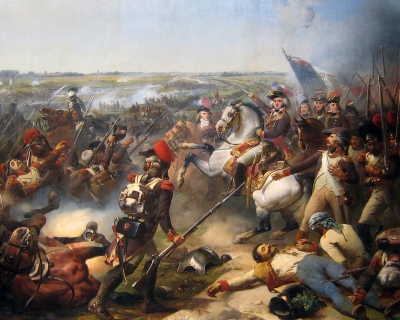The Battle of Neerwinden (18 March 1793) saw a Republican French army led by Charles Franois Dumouriez attack a Coalition army commanded by Prince Josias of Saxe-Coburg-Saalfeld. The Coalition army of the Habsburg monarchy together with a small contingent of allied Dutch Republic troops repulsed all French assaults after bitter fighting and Dumouriez conceded defeat, withdrawing from the field. The French position in the Austrian Netherlands swiftly collapsed, ending the threat to the Dutch Republic and allowing Austria to regain control of its lost province. The War of the First Coalition engagement was fought at Neerwinden, located 57 kilometres (35 mi) east of Brussels in present-day Belgium.
After Dumouriez's victory at Jemappes in November 1792, the French armies rapidly overran most of the Austrian Netherlands. Rather than driving the Austrians to the west bank of the Rhine River, Dumouriez and the French government became preoccupied with a war with the Dutch Republic. During the breathing space offered by her enemy, Austria assembled an army under the Prince of Coburg and struck back. After a French covering force was routed by Coburg at Aldenhoven, Dumouriez began gathering his army for a counterstroke.
Coburg took up a defensive position at Neerwinden and awaited the confident Dumouriez's attack. The Coalition army was outnumbered in infantry but possessed a two-to-one superiority in cavalry. After intense fighting, Coburg's troops repulsed the attacks of the French center and right wing. When Dumouriez found that his left wing was driven off the battlefield, he began retreating. The defeat led to mass desertions from the discouraged French volunteers. In the face of the military collapse, Dumouriez negotiated a free withdrawal of French troops in return for the surrender of Belgium and Dutch territory. Soon, Dumouriez was plotting against his own government and when his plans failed, he defected to the Austrians, leaving the French army in chaos.
The Flanders Campaign (or Campaign in the Low Countries) was conducted from 20 April 1792 to 7 June 1795 during the first years of the War of the First Coalition. A coalition of states representing the Ancien Régime in Western Europe – Austria (including the Southern Netherlands), Prussia, Great Britain, the Dutch Republic (the Northern Netherlands), Hanover and Hesse-Kassel – mobilised military forces along all the French frontiers, with the intention to invade Revolutionary France and end the French First Republic. The radicalised French revolutionaries, who broke the Catholic Church's power (1790), abolished the monarchy (1792) and even executed the deposed king Louis XVI of France (1793), vied to spread the Revolution beyond France's borders, by violent means if necessary.
A quick French success in the Battle of Jemappes in November 1792 was followed by a major Coalition victory at Neerwinden in March 1793. After this initial stage, the largest of these forces assembled on the Franco-Flemish border. In this theatre a combined army of Anglo-Hanoverian, Dutch, Hessian, Imperial Austrian and, south of the river Sambre, Prussian troops faced the Republican Armée du Nord, and (further to the south) two smaller forces, the Armée des Ardennes and the Armée de la Moselle. The Allies enjoyed several early victories, but were unable to advance beyond the French border fortresses. Coalition forces were eventually forced to withdraw by a series of French counter-offensives, and the May 1794 Austrian decision to redeploy any troops in Poland.
The Allies established a new front in the south of the Netherlands and Germany, but with failing supplies and the Prussians pulling out they were forced to continue their retreat through the arduous winter of 1794/5. The Austrians pulled back to the lower Rhine and the British to Hanover from where they were eventually evacuated. The victorious French were aided in their conquest by Patriots from the Netherlands, who had previously been forced to flee to France after their own revolutions in the north in 1787 and in the south in 1789/91 had failed. These Patriots now returned under French banners as "Batavians" and "Belgians" to 'liberate' their countries. The republican armies pushed on to Amsterdam and early in 1795 replaced the Dutch Republic with a client state, the Batavian Republic, whilst the Austrian Netherlands and the Prince-Bishopric of Liège were annexed by the French Republic.
Prussia and Hesse-Kassel would recognise the French victory and territorial gains with the Peace of Basel (1795). Austria would not acknowledge the loss of the Southern Netherlands until the 1797 Treaty of Leoben and later the Treaty of Campo Formio. The Dutch stadtholder William V, Prince of Orange, who had fled to England, also initially refused to recognise the Batavian Republic, and in the Kew Letters ordered all Dutch colonies to temporarily accept British authority instead. Not until the 1801 Oranienstein Letters would he recognise the Batavian Republic, and his son William Frederick accept the Principality of Nassau-Orange-Fulda as compensation for the loss of the hereditary stadtholderate.

1793Mar, 18
Flanders Campaign of the French Revolution, Battle of Neerwinden.
Choose Another Date
Events on 1793
- 21Jan
Louis XVI of France
After being found guilty of treason by the French National Convention, Louis XVI of France is executed by guillotine. - 23May
Flanders Campaign
Battle of Famars during the Flanders Campaign of the War of the First Coalition. - 23Jul
Mainz
Kingdom of Prussia re-conquers Mainz from France. - 27Aug
Siege of Toulon
French Revolutionary Wars: The city of Toulon revolts against the French Republic and admits the British and Spanish fleets to seize its port, leading to the Siege of Toulon by French Revolutionary forces. - 5Sep
French National Convention
French Revolution: The French National Convention initiates the Reign of Terror.

 English
English  español
español  français
français  português
português  русский
русский  العربية
العربية  简体中文
简体中文 